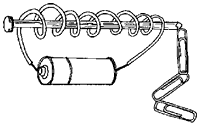|
In 1831, two scientist working independently – Michael
Faraday in England, and Joseph Henry in America – formulated the
electromagnetic induction principle. Basically, they developed techniques
for converting magnetism into electricity. The concept in brief
- a change in magnetic flux through a conducting circuit produces
a current in the circuit. This opened the door for widespread production
and distribution of electricity. In January of 1882, the first public
power station using an electric generator was opened, followed by
a similar station in New York City. Both of these stations generated
DC current. In 1890, the first commercial AC generator was built
in Lauffen, Germany to service the nearby city of Frankfurt.
|
The connection between
electricity and magnetism
|
 |
As a kid, did you ever do the science experiment
where you coil a wire around a nail and then hook up the two
ends of the wire to a battery? Do you remember what happened?
The nail became magnetic.
|
|
So obviously there’s a connection between electricity and
magnetism. It works like this: add electricity to a coil,
you create a magnetic field. Conversely, apply a magnetic
field to a coil, you get electricity. A generator is basically
a magnet inside a coil. Spin the magnetic, and you get electricity.
Note: If you’re going to try this experiment, ALWAYS use
a battery – don’t ever hook up the wire to a wall outlet.
It’s very dangerous, and you can cause a fire – not to mention
give yourself a nasty shock. See short circuit.
|
Ok, so we know who came up with it, but... What
is electricity?
|